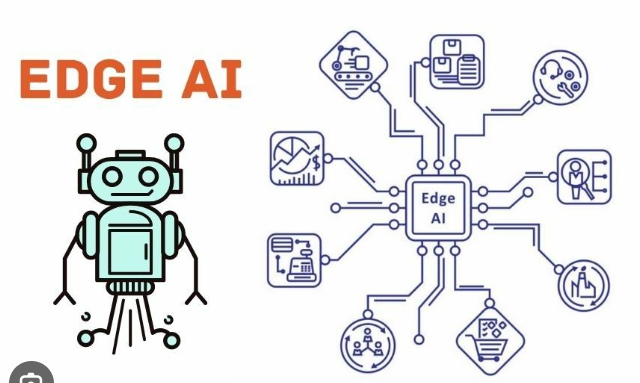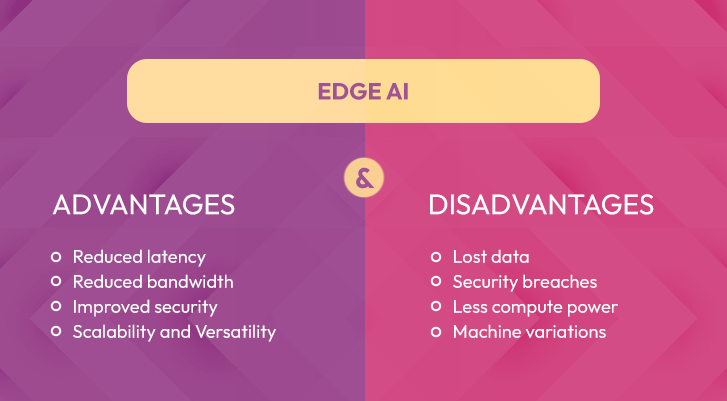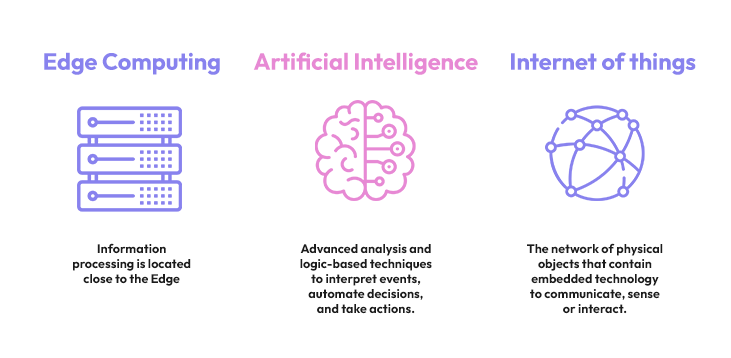
Edge AI
Exploring Edge AI – Revolutionizing Real-Time Data Processing 2024
http://Exploring Edge AI – Revolutionizing Real-Time Data Processing 2024
Introduction to Edge AI
Edge AI refers to artificial intelligence applications that run directly on edge devices, such as IoT gadgets, smartphones, and embedded systems, rather than relying on centralized data centers or cloud computing. This approach minimizes latency, enhances privacy, and allows for faster data processing and decision-making at the device level.
Why Edge AI Matters
With the explosive growth of IoT devices and smart technologies, the need for real-time processing has become critical. Edge AI ensures that data is processed closer to its source, which:
- Reduces latency and response time by eliminating the need to send data to remote servers.
- Improves data privacy by minimizing data transfer to the cloud, ensuring user-sensitive data stays local.
- Enhances the overall efficiency of applications that rely on immediate actions, such as autonomous vehicles or industrial equipment.

Core Components of Edge AI
- Edge Devices: Hardware capable of running AI models locally, such as Raspberry Pi, NVIDIA Jetson Nano, smartphones, and embedded systems with specialized chipsets.
- AI Models: Pre-trained models optimized for lightweight inference, ensuring fast computation with minimal resources.
- Connectivity: Networks facilitating data flow between edge devices and, if needed, cloud systems for additional processing or model updates.
Use Cases of Edge AI
1. Real-Time Data Processing Edge AI is leveraged for real-time analysis in various scenarios where rapid decision-making is essential:
- Video Surveillance: Smart cameras can analyze video footage on the device itself to identify suspicious behavior or unauthorized access without uploading large data sets to cloud servers.
- Autonomous Vehicles: Edge AI helps in real-time object detection, path planning, and decision-making to ensure safe and efficient vehicle operation.
2. Smart Homes Home automation systems are among the most prominent applications of Edge AI:
- Voice-Activated Assistants: Devices like Amazon Echo or Google Nest Hub process voice commands locally for quick responses.
- Security Systems: AI-enabled cameras and sensors analyze live feeds and trigger alerts based on predefined parameters without sending data externally.
3. Industrial IoT (IIoT) In manufacturing and heavy industries, Edge AI plays a vital role in optimizing processes and enhancing safety:
- Predictive Maintenance: Machine learning models predict equipment failures by analyzing sensor data locally, thus avoiding costly downtime and repairs.
- Quality Control: Automated inspection systems on production lines detect defects in real-time and flag products that don’t meet quality standards.
4. Healthcare Edge AI is crucial for applications that require real-time monitoring and decision-making:
- Wearable Devices: Health trackers process data locally to monitor vital signs, detect anomalies, and alert users or healthcare providers.
- Medical Imaging: Portable diagnostic devices can process medical scans on-site, delivering immediate results in emergency situations.
5. Retail and Customer Interaction Retailers use Edge AI to enhance customer experiences and streamline operations:
- Smart Shelves: Sensors and cameras equipped with AI capabilities can detect when a product is out of stock and trigger restocking processes.
- Personalized Marketing: On-device data processing enables real-time personalized recommendations based on customer behavior without sending data to the cloud.
Benefits of Edge AI
- Low Latency: By processing data at the edge, AI-driven applications can respond in milliseconds, crucial for time-sensitive operations like autonomous vehicles or financial trading systems.
- Reduced Bandwidth: With less data transmitted to the cloud, network traffic and associated costs decrease.
- Enhanced Privacy and Security: Edge AI ensures that sensitive data is kept on local devices, aligning with stricter data protection regulations like GDPR.
- Offline Functionality: Edge devices can continue to operate effectively even in areas with limited or no internet connectivity.
Challenges in Implementing Edge AI
- Limited Processing Power: Edge devices often have less computational capability compared to centralized cloud servers, making it essential to optimize models for low power consumption.
- Energy Consumption: Continuous data processing can significantly impact the battery life of portable devices, necessitating energy-efficient algorithms.
- Model Optimization: AI models need to be optimized for reduced size and faster inference to run within the constraints of edge hardware.
Key Technologies Powering Edge AI
- Machine Learning Frameworks: Libraries such as TensorFlow Lite, PyTorch Mobile, and ONNX Runtime enable developers to deploy AI models on mobile and embedded devices.
- Edge Hardware: Custom chipsets, including Google’s Edge TPU, NVIDIA’s Jetson platform, and Apple’s Neural Engine, are designed to accelerate AI processing while minimizing power usage.
- Model Compression Techniques: Techniques like quantization, pruning, and knowledge distillation are used to create smaller, faster models suitable for edge deployment.
Example: Deploying a Simple Edge AI Model
To illustrate, consider deploying an image classification model on an edge device. The AI model might use a linear classifier:
Equation: y=W⋅x+by = W \cdot x + by=W⋅x+b
Where:
- WWW represents the weights,
- xxx is the input feature vector,
- bbb is the bias term,
- yyy is the output prediction.
HTML Code for Easy Copy:
Security Considerations in Edge AI
Edge AI, while beneficial, also brings security challenges:
- Device Security: Edge devices can be more vulnerable to physical tampering, so secure boot processes and hardware-based security modules are essential.
- Data Integrity: On-device data processing must ensure the integrity of the results, making it crucial to implement robust encryption and validation mechanisms.
- Model Theft: Protecting AI models from unauthorized access and copying is critical. Techniques like model watermarking help safeguard intellectual property.
Edge AI Unlocks Many Benefits for End Users
The ability to process AI on devices or close to the data source unlocks 11 impressive benefits for companies. These include:
- Improved bandwidth efficiency
- Reduced latency
- Fewer size and weight constraints
- Enhanced privacy
- Lower hardware costs
- The ability to function offline
- High availability
- Improved model accuracy
- Sustainability advantages
- Lower costs compared to cloud-based AI
- Increased levels of automation
There are also use cases that benefit tremendously from Edge AI. These include banking, content and ad services, delivery logistics systems, home security systems, weather technologies, recommendation engines, and more.
Edge AI helps make all of this possible, and as we continue to build ever-stronger technologies, it’s important to think about how they aid our quality of life.
Future Trends in Edge AI
- Federated Learning: A decentralized approach that allows devices to train shared models without centralizing raw data, enhancing both data privacy and efficiency.
- Integration with 5G: The high-speed, low-latency nature of 5G will enable edge devices to communicate more efficiently, allowing for enhanced real-time applications.
- AI-Driven Energy Management: Future developments in algorithm efficiency will help reduce energy consumption, making Edge AI sustainable for wider adoption.
Understanding the Advantages and Disadvantages of Edge AI

Two technologies that impact data flow management are Edge computing and Edge AI.
The quantity of data generated by business transactions is growing exponentially. To help manage these extraordinary amounts of data, new and innovative methods of data flow management have made their way onto the playing field.
Edge computing is one of these methods as it analyzes and stores data closer to users. This data storage and analysis can take place on Edge-enabled devices, taking pressure off centralized servers by lessening the amount of data sent to them.
The combination of Edge computing and AI has created a new frontier known as Edge AI. Edge AI takes advantage of the many benefits of Edge Computing, such as reduced latency, improved bandwidth, and the ability to function offline.
Like all technologies, Edge computing and Edge AI have advantages and disadvantages. Users must consider this to determine if Edge technologies are a good fit for them and their business.
The advantages of Edge AI include:
1. Reduced latency
Edge AI takes some of that load off the cloud platform, reducing latency. Additionally, by analyzing locally, the return time from the cloud to the company using the information is reduced, leaving the cloud-based platform free for other tasks such as analytics.
2. Reduced bandwidth
Just as Edge AI offers reduced latency, it also reduces bandwidth. Because more data is processed, analyzed, and stored locally, less data is sent to the cloud. This reduction in data flow minimizes user costs.
3. Security
Edge AI results in less data being sent to centralized cloud storage. The situation of having “all your eggs in one basket” is minimized by processing and storing some data in an edge network. If data does need to go to the cloud, the Edge filters redundant, extraneous, and unneeded data, sending only what’s important.
4. Scalability and Versatility
As Edge devices become more common, they’re often available for cloud-based platforms. Additionally, as OEM equipment manufacturers make Edge capability native to their equipment, the system will be much easier to scale. This proliferation also allows local networks to remain functional even when upstream or downstream nodes are down.
The disadvantages of Edge AI include:
1. Lost data
When implemented, an Edge AI system must be thoroughly planned out and programmed to avoid data loss. Many Edge devices discard irrelevant data after collection (as they should), but if the data dumped is relevant, that data is lost, and any analysis will be flawed.
2. Security
Just as there’s a security advantage at the cloud and enterprise levels, there’s a security risk at the local level. It does a company no good to have a cloud-based provider with excellent security only to have their local network open to breach. While cloud-based security is becoming more robust, it’s usually human error and locally used applications and passwords that open the door to most breaches.
3. Less compute power
Edge AI is excellent, but it still lacks the computing power available for cloud-based AI.
Because of this, only select AI tasks can be performed on an Edge device. Cloud computing will still handle creating and serving large models, but Edge devices can perform on-device inference with smaller models. Edge devices can also handle small transfer learning tasks.
4. Machine variations
Relying on Edge devices means there’s significantly more variation in machine types. So, failures are more common.
Edge AI positively impacts the IoT
The IoT (internet of things) can be a powerful business asset. Still, the data generated by these devices has a long way to travel if a business solely relies on cloud computing and cloud-based AI.
Additionally, as companies continue to invest in IoT, adding sensors to legacy assets, their bandwidth load will quickly become heavy.
Edge intelligence addresses these issues by delivering real-time insights directly within operations where data is generated.
Most IoT configurations work like this: Sensors or devices are connected directly to the internet through a router, providing raw data to a backend server. On these servers, machine learning algorithms help predict various cases that might interest managers.
However, things get tricky when too many devices clog the network. For example, perhaps there’s too much traffic on local Wi-Fi or data being piped to the remote server. To help alleviate these issues, machine learning algorithms can be deployed on local servers or the devices themselves.
This is known as Edge AI.
Edge AI benefits the IoT by running machine learning algorithms on locally operated computers or embedded systems instead of on remote servers. It provides the opportunity to sort through data and decide what’s relevant before sending it off to a remote location for further analysis.

Additionally, Edge AI for the IoT improves performance as it can make decisions virtually without latency. This is possible because data analysis can be done entirely on an Edge-enabled IoT device.
Conclusion
Edge AI is revolutionizing the way data is processed and acted upon, making technologies smarter and more efficient. As more advancements in hardware and algorithms unfold, the future of Edge AI will continue to enable transformative applications across industries. Whether in smart homes, healthcare, or industrial settings, Edge AI stands at the forefront of a smarter, more connected world.